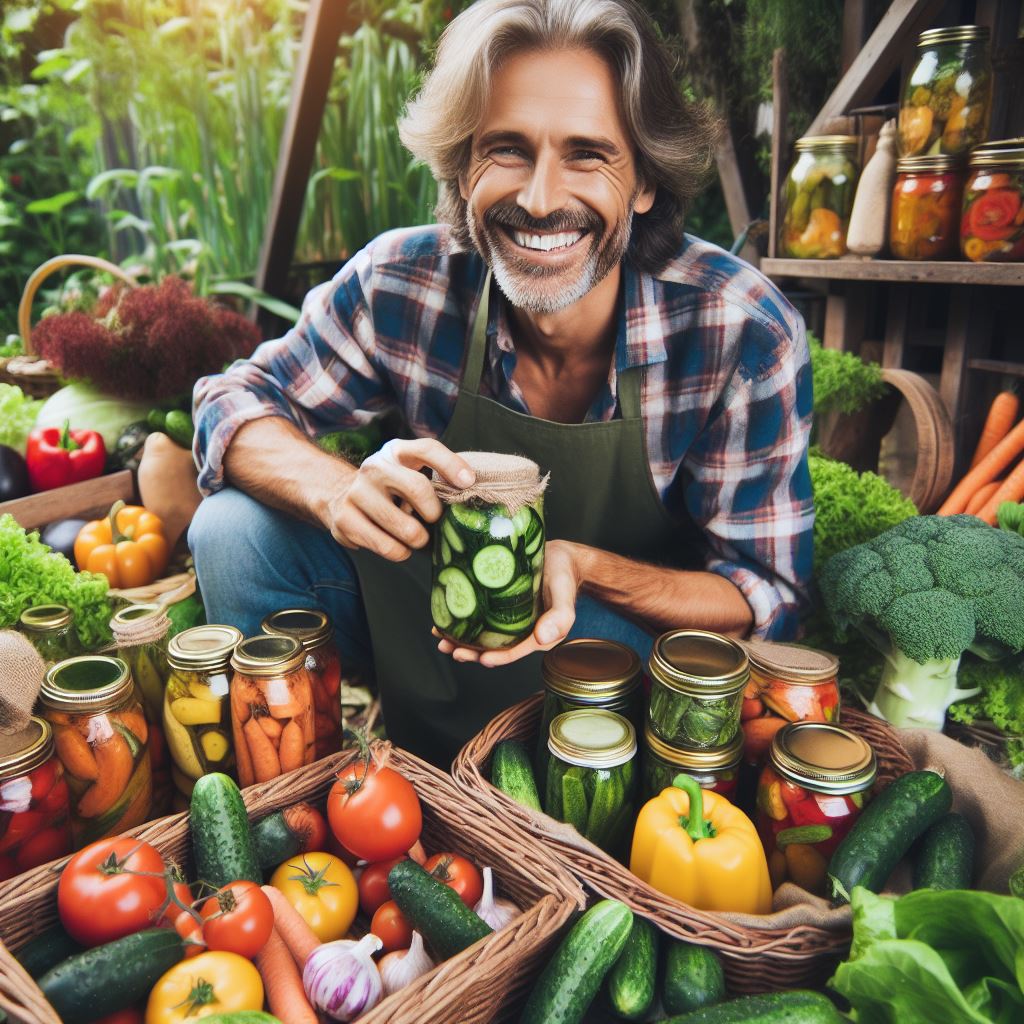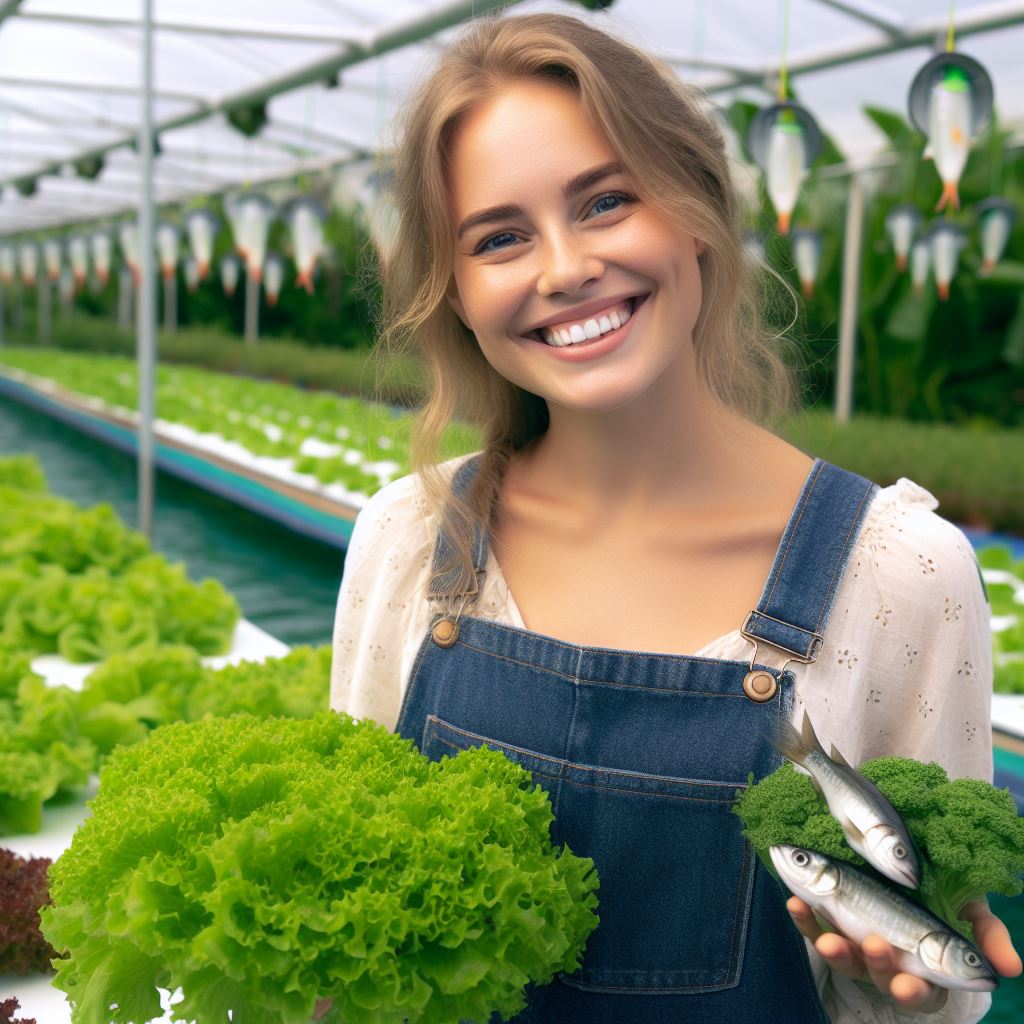Introduction
A. The Importance of Harvesting and Preserving Organic Produce
Harvesting and preserving organic produce play pivotal roles in sustainable living and fostering a healthier lifestyle.
- Nutrient-Rich Goodness: Organic farming ensures that your produce is packed with essential nutrients, promoting overall well-being.
- Reduced Environmental Impact: Opting for organic products supports eco-friendly practices, minimizing harmful effects on the environment.
- Chemical-Free Delight: Say goodbye to harmful pesticides and chemicals. Organic farming relies on natural methods, ensuring a chemical-free harvest.
B. Benefits of Organic Farming and Consumption
- Healthier You: Consuming organic produce means fewer toxins in your body, contributing to a healthier and more energetic lifestyle.
- Environmental Harmony: Organic farming methods promote biodiversity, preserving the ecosystem and maintaining a delicate environmental balance.
- Taste the Difference: Experience the true, unadulterated flavors of fruits and vegetables without the artificial enhancements found in conventional produce.
In this section, we will delve deeper into the intricacies of harvesting and preserving organic produce, unlocking the secrets to a sustainable and nutritious culinary journey.
Harvesting Techniques for Organic Produce
Harvesting organic produce requires careful timing and the right tools and methods to ensure optimal flavor and nutritional value.
Here are some essential techniques:
A. Knowing when to harvest different types of produce
- Observe the characteristic color, size, and texture of each type of produce.
- Check the stage of maturity indicated by the seed packet or plant label.
- Learn the specific signs of ripeness for different fruits, vegetables, and herbs.
B. Proper tools and methods for harvesting organic crops
- Use clean, sharp pruners or shears to cut plants at the base or stem.
- For leafy greens or herbs, gently pluck the outer leaves or stems to encourage new growth.
- Handle delicate produce like berries and tomatoes with care to avoid bruising.
- Use a digging fork or garden shovel to harvest root crops carefully without damaging the roots.
C. Tips for ensuring optimal flavor and nutritional value
- Harvest produce in the morning when it’s cool to preserve freshness and flavor.
- Avoid harvesting produce after rain, as it may be waterlogged and prone to rot.
- Separate damaged or overripe produce from the rest to prevent spoilage.
- Store harvested produce in clean and cool containers to maintain its nutritional value.
- Use harvested produce as soon as possible to enjoy the maximum nutritional benefits.
- If storing produce, prioritize consuming fruits and vegetables with a shorter shelf life.
By following these harvesting techniques, you can enjoy the abundant rewards of your organic produce while maximizing its flavor and nutritional value.
Read: Urban Oasis: 5 Steps to Perfect Container Gardens
Preservation Methods for Organic Produce
A. Understanding the Importance of Preserving Organic Produce
Preserving organic produce is essential to ensure that the hard work put into growing and harvesting is not wasted.
By preserving organic fruits and vegetables, you can enjoy their freshness and nutritional benefits for an extended period.
B. Common Preservation Methods
- Canning: One of the most popular preservation methods for organic produce is canning.
Canning involves placing fruits or vegetables in jars and sealing them with heat.
This process kills bacteria and other microorganisms, making the produce safe for consumption. - Freezing: Freezing is another effective way to preserve organic fruits and vegetables.
By freezing, you can retain the taste, texture, and nutrients of the produce for an extended period.
However, it is important to blanch the produce before freezing to ensure optimal preservation. - Drying: Drying organic produce involves removing moisture from the fruits or vegetables, preventing the growth of bacteria and molds.
This method can be achieved by air drying, sun drying, or using a food dehydrator. Dried produce can be stored in airtight containers for a long time.
C. Benefits and Drawbacks of Each Preservation Technique
1. Canning
- Benefits: Canning helps to retain the flavor, texture, and nutritional value of organic produce. It allows for long-term storage without the need for refrigeration or freezing.
- Drawbacks: The process of canning requires specific equipment, such as canners and jars. It also involves cooking the produce, which may result in a slight loss of nutrients.
2. Freezing
- Benefits: Freezing is a convenient preservation method that allows for easy and quick access to preserved produce. It retains the freshness and quality of organic fruits and vegetables.
- Drawbacks: Freezing requires significant freezer space, and the produce may lose some texture and nutritional value over time. It is important to properly package and label the frozen items to avoid freezer burn.
3. Drying
- Benefits: Dried organic produce is lightweight and takes up less space. It can be carried easily for outdoor activities such as hiking or camping. Dried fruits make for a healthy and delicious snack option.
- Drawbacks: The drying process can be time-consuming, and the produce may lose some of its natural color and flavor. It is important to store dried items properly to prevent moisture absorption.
D. Tips for Successful Preservation
- Choose produce at its peak: For optimal preservation, select organic fruits and vegetables when they are at their peak freshness.
- Proper cleaning and preparation: Thoroughly wash and clean the produce before preserving. Remove any damaged or spoiled parts.
- Follow recipes and guidelines: For canning, freezing, or drying, follow reliable recipes and guidelines to ensure safety and preservation quality.
- Use proper storage containers: Select containers that are suitable for each preservation method. For canning, use glass jars with proper seals. For freezing, use freezer-safe bags or containers. For drying, use airtight containers.
- Label and date: Properly label each preserved item with the date of preservation. This helps to keep track of freshness and prevents confusion.
Preserving organic produce allows you to enjoy the goodness of fresh fruits and vegetables throughout the year.
Whether you choose canning, freezing, or drying, each preservation method comes with its own benefits and drawbacks.
By following proper techniques and guidelines, you can successfully preserve your organic produce and savor their flavors for months to come.
Read: Eco-Friendly Gardening: Sustainable Practices
Canning Organic Produce
A. Step-by-step guide for canning organic fruits and vegetables
Canning your organic bounty ensures a taste of summer all year.
Follow these steps for a successful canning experience.
- Prepare Your Produce: Wash fruits and vegetables thoroughly. Peel, slice, or chop them according to your recipe.
- Sterilize Jars and Lids: Submerge jars and lids in boiling water for 10 minutes. Air-dry on a clean towel.
- Choose Your Canning Method: Pick between water bath canning for high-acid foods and pressure canning for low-acid ones.
- Create a Flavorful Brine or Syrup: Craft a brine or syrup to enhance the taste of your produce. Consider honey or maple syrup for sweetness.
- Pack the Jars: Pack your sterilized jars tightly with the prepared produce, leaving adequate headspace.
- Add the Brine or Syrup: Pour the flavorful liquid over the produce, ensuring it covers the contents while maintaining the headspace.
- Remove Air Bubbles: Slide a non-metallic spatula around the inside of the jar to release trapped air bubbles.
- Wipe Jar Rims: Using a clean, damp cloth, wipe the rims of the jars to remove any residue that could affect the seal.
- Secure Lids and Rings: Place sterilized lids on the jars and screw on the metal rings until they’re fingertip-tight.
- Process in Canner: Follow the recommended processing time for your chosen canning method, adjusting for altitude if necessary.
B. Necessary Equipment and Ingredients
- Equipment: Gather canning jars, lids, rings, a water bath canner or pressure canner, a jar lifter, and a funnel.
- Ingredients: Ensure high-quality organic produce and choose brine or syrup ingredients based on your recipe.
C. Proper Storage and Shelf Life for Canned Organic Produce
- Cool Jars Properly: After processing, allow jars to cool on a clean towel or cooling rack. Listen for the satisfying pop as lids seal.
- Check Seals: Once cool, press the center of each lid to ensure it doesn’t pop back—a sign of a successful seal.
- Store in a Cool, Dark Place: Keep canned goods in a cool, dark, and dry environment. A pantry or cellar is ideal.
- Monitor Shelf Life: Most canned produce remains at peak quality for 1-1.5 years. Label jars with the date for easy tracking.
With this step-by-step guide and the right equipment, your canned organic produce will be a pantry staple.
Transform Your Agribusiness
Unlock your farm's potential with expert advice tailored to your needs. Get actionable steps that drive real results.
Get StartedEnjoy the fruits of your labor year-round!
Read: Balcony Farming: Urban Organic Strategies
Freezing Organic Produce
A. Best practices for freezing various types of organic produce
Freezing organic produce is an excellent way to extend the shelf life of your harvest while preserving its nutritional value.
Here are some best practices for freezing various types of organic produce:
- Preparation is key: Before freezing your organic produce, make sure to wash and dry it thoroughly to remove any dirt or debris.
- Blanching: Blanching vegetables like broccoli, carrots, and peas before freezing helps preserve their color, texture, and flavor.
- Flash freezing: Spread your organic produce in a single layer on a baking sheet and place it in the freezer for a couple of hours to allow individual pieces to freeze separately.
- Proper packaging techniques: To prevent freezer burn and maintain the quality of your organic produce, use airtight containers, freezer bags, or vacuum seal bags.
- Labeling: Always label your frozen organic produce with the contents and date of freezing to ensure proper rotation.
B. Guidelines for maintaining flavor and quality during freezing
- Choose ripe produce: Only freeze organic produce that is at its peak ripeness for the best flavor and texture after thawing.
- Remove excess air: When using freezer bags, remove as much air as possible before sealing to prevent freezer burn.
- Keep consistent temperature: Maintain a constant freezing temperature of 0°F (-18°C) or below to prevent the growth of bacteria and enzymes.
- Consider blanching or steaming: For certain fruits, blanching or steaming for a short time can help preserve their texture and flavor.
- Use quality packaging materials: Invest in high-quality freezer bags, containers, or vacuum seal bags to maintain the freshness of your organic produce.
- Utilize airtight containers: Airtight containers are ideal for freezing soups, sauces, or purees made from your organic produce.
C. Ensuring long lasting storage
By following these guidelines, you can ensure that your frozen organic produce retains its flavor, nutrients, and overall quality when you’re ready to enjoy it later.
With proper freezing techniques and packaging, you can conveniently store your organic produce for months without compromising its taste or nutritional value.
Whether you’re freezing vegetables, fruits, or homemade organic baby food, the key is to maintain the freshness and quality of your harvest throughout the freezing process.
Freezing organic produce allows you to enjoy the flavors of your garden year-round, even when certain fruits and vegetables are out of season.
Plus, it’s a cost-effective way to reduce waste and make the most of your organic harvest.
So, whether you have an abundance of homegrown organic produce or want to take advantage of seasonal sales at your local farmer’s market, don’t hesitate to freeze your organic treasures.
With the right techniques and tools, your frozen organic produce will be just as delicious and nutritious as when it was freshly harvested!
Read: Pollinator-Friendly Gardening: Bees & More

Drying Organic Produce
Drying organic produce is an effective method to preserve and extend the shelf life of your harvest.
There are different drying methods you can use, such as oven drying, sun drying, and using a dehydrator.
Each method has its own advantages and suitability depending on the type of produce you have and the resources available to you.
A. Different Drying Methods
1. Oven Drying
Oven drying is a convenient method that can be done in any household with an oven.
It involves spreading the produce evenly on baking sheets and setting the oven at a low temperature, usually around 140-150°F (60-65°C).
Leave the oven slightly open to allow moisture to escape.
Check regularly to ensure the produce is drying evenly.
2. Sun Drying
Sun drying is the oldest method used to dry produce.
It requires warm weather with low humidity.
Arrange the produce on screens or trays in a sunny area.
Make sure to protect the produce from insects or birds using nets or cheesecloth.
Stir or turn the produce regularly to ensure even drying.
Showcase Your Farming Business
Publish your professional farming services profile on our blog for a one-time fee of $200 and reach a dedicated audience of farmers and agribusiness owners.
Publish Your Profile3. Dehydrator
A dehydrator is a modern and efficient drying method. It uses low heat and a fan to remove moisture from the produce.
Follow the manufacturer’s instructions on temperature and time settings.
Arrange the produce on the trays and place them inside the dehydrator.
Check regularly to ensure the produce is drying evenly.
B. Suitable Produce for Drying and Best Practices
Not all produce is suitable for drying.
Some popular choices for drying include herbs, fruits like apples, pears, and cherries, as well as vegetables like tomatoes and peppers.
Here are some best practices to keep in mind when drying organic produce:
1. Choose Fresh and Ripe Produce
Always start with high-quality, ripe produce for the best drying results.
Avoid overripe or underripe produce as they may not dry properly.
2. Wash and Blanch as Needed
Wash the produce thoroughly and remove any dirt or debris.
For certain vegetables, blanching may be necessary to preserve color and ensure proper drying.
3. Prevent Browning
To prevent browning, soak fruits like apples or pears in a solution of lemon juice and water before drying.
4. Slice Evenly
When drying fruits or vegetables, slice them evenly to ensure consistent drying.
Thinner slices will dry faster than thicker ones.
5. Avoid Overcrowding
Leave enough space between the pieces of produce to allow proper air circulation.
Overcrowding can lead to uneven drying or even mold formation.
6. Store in Airtight Containers
Once your organic produce is fully dried, store it in airtight containers or glass jars with tight lids.
Keep them in a cool, dark place to maintain their quality.
C. Storing and Using Dried Organic Produce
Dried organic produce has a long shelf life if stored properly.
Here are some tips for storing and using your dried organic produce:
- Label and Date: Always label your containers with the name and date of drying. This helps you keep track of freshness and quality.
- Rehydrate Before Use: When you want to use your dried produce, rehydrate it by soaking it in water, stock, or any liquid as required by your recipe. This will ensure the best texture and taste.
- Use in Cooking: Dried organic produce can be used in a variety of recipes such as soups, stews, sauces, and baked goods. Experiment and enjoy the flavors and nutrients all year round!
Drying organic produce is a simple and rewarding way to enjoy the fruits of your labor long after harvest season.
Experiment with different drying methods and enjoy the convenience and flavor of preserved organic produce!
Tips for Maximizing Shelf Life and Quality
Proper handling and storage of harvested organic produce are essential for maintaining its freshness and quality.
Here are seven tips to help you maximize the shelf life and overall quality of your organic produce:
- Wash and dry: Before storing, make sure to wash your produce thoroughly and dry it completely to remove any dirt or moisture.
- Remove damaged or spoiled items: Inspect your produce carefully and discard any items that are bruised, damaged, or showing signs of spoilage.
- Separate ethylene gas producers: Some fruits and vegetables produce ethylene gas, which can accelerate the ripening process of other produce. Keep them separate to avoid premature spoilage.
- Utilize root cellars and cold storage spaces: These spaces provide the ideal conditions for storing organic produce, as they offer cool temperatures and high humidity levels.
- Control humidity: Most fruits and vegetables require different humidity levels for optimal storage. Use a humidifier or dehumidifier to adjust the humidity accordingly.
- Store in proper containers: Use breathable containers or bags that allow air circulation to prevent the buildup of moisture and mold.
- Rotate your stock: When adding new produce to your storage, make sure to place it at the back and use the older produce first to avoid wasting any items.
By following these tips, you can extend the shelf life and maintain the quality of your organic produce, ensuring that it stays fresh and delicious for longer periods.
Using Preserved Organic Produce
When it comes to using preserved organic produce, there are a few important factors to consider.
Firstly, it is crucial to ensure the safe and healthy use of preserved organic produce.
Preserving fresh produce allows you to enjoy the flavors and benefits of organic food throughout the year.
However, it’s essential to follow proper preservation techniques to maintain food safety.
A. Ensuring Safe and Healthy Use of Preserved Organic Produce
- Always start by inspecting the preserved organic produce before use.
- Check for any signs of spoilage, such as discoloration, mold, or off-putting smells.
- If the preserved produce appears to be in good condition, proceed with using it.
- Remember to wash and handle the preserved organic produce just like fresh produce.
- Thoroughly rinse fruits and vegetables under running water before consumption.
- Follow safe handling practices to avoid cross-contamination with other food items.
- Store opened jars of preserved organic produce in the refrigerator and consume within the recommended time.
- If you ever doubt the safety of the preserved produce, it’s best to discard it.
B. Creative Recipes and Ideas for Incorporating Preserved Produce
Preserved organic produce can add delicious flavors and nutrition to a variety of dishes.
Here are some creative recipes and ideas to inspire you:
- Make a flavorful pasta sauce by simmering preserved organic tomatoes with herbs and spices.
- Create a vibrant salad by adding pickled organic vegetables like cucumbers, carrots, and radishes.
- Blend preserved organic berries into smoothies or use them as toppings for yogurt or oatmeal.
- Turn preserved organic fruits into a luscious compote or jam to spread on toast or pancakes.
- Add preserved organic herbs to soups, stews, or marinades for an extra burst of flavor.
- Use preserved organic peppers to make spicy salsas, relishes, or hot sauces.
- Bake a scrumptious pie or tart using preserved organic apples, peaches, or cherries.
- Experiment with different combinations of preserved organic produce to create unique dishes.
C. Inspiring Others to Join the Organic Food Movement
By utilizing preserved organic produce, you can not only enjoy its benefits but also inspire others to join the organic food movement.
Here’s how:
- Share your preserved organic produce recipes and creations with friends, family, and on social media.
- Educate others about the advantages of organic farming and the importance of preserving organic produce.
- Encourage people to grow their own organic food and explore preservation methods.
- Organize workshops or cooking classes to teach others about preserving organic produce.
- Collaborate with local farmers or community gardens to promote the use of preserved organic produce.
- Participate in farmers markets or food festivals to showcase the versatility of preserved organic produce.
- Be an advocate for sustainable and eco-friendly practices in the food industry.
- Spread awareness about the negative impacts of conventional farming and the benefits of consuming organic produce.
Using preserved organic produce is not only a practical way to enjoy organic food year-round but also an opportunity to inspire others and contribute to a healthier and more sustainable food system.
Conclusion
The importance of harvesting and preserving organic produce cannot be overstated.
It ensures the availability of fresh, healthy food while reducing waste and supporting sustainable farming practices.
We encourage everyone to practice sustainable farming and consumption to protect our planet and promote a healthier future.
By doing so, we can contribute to a more sustainable and environmentally friendly world.
Together, let’s take action and make a difference for ourselves and future generations.




